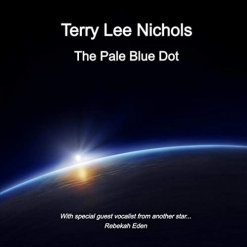The Pale Blue Dot is the third album from composer/multi-instrumentalist Terry Lee Nichols and what a mind-blowing musical experience it is! In Nichols’ own words: “In
The Pale Blue Dot, I try to provide resonance to our ever-growing knowledge of who we are, where we came from, and what may help life on this planet continue well into the future. The language used is intended to celebrate scientific achievement in a way that fosters spiritual revelation, examines the social fabric of our species, and provides hope for our future.”
The CD package includes a colorful booklet with gorgeous illustrations and the story behind each of the eleven tracks. The booklet also offers insightful information about the origins of the universe and planet Earth, musical experiences and brain development in young children, love, and global warming. How’s that for variety? And I haven’t even touched on the music yet, which is stellar! Most of the tracks are orchestrated with piano and two include vocalise performances by Rebekah Eden whose beautiful voice contributed to Nichols’ previous album,
We Have Only Come To Dream (2018). (The booklet is also accessible on Nichols’ website using the “Listen” link.)
The Pale Blue Dot opens with “In the beginning… (Quantum Fluctuations),” a smooth, somewhat mysterious piece inspired by the origins of what we now know as Big Bang cosmology. More ambient than most of the other tracks, it offers feelings of vast space and total darkness. “Cosmic Dark Ages,” also quite ambient and spacious, refers to a time after the Big Bang, but before stars or galaxies existed. The piano provides a simple melody - a quiet voice in the vast darkness. “First Stars” begins with a sustained tone and isolated flickers of light that gradually grow and expand. The piece was scored to six pianos, orchestra and Latin percussion, and at the mid-point of the track, the orchestra explodes triumphantly and then recedes as the keyboard sparkles and dances, only to rebuild and explode again, this time in the form of a celebratory Latin dance. “Stardust (Clouds of Gas and Dust)” is a favorite. Piano, vocalise and orchestra tell a darkly beautiful story of the creation of stars within clouds of dust. I also really like “Asteroids,” which opens with a short piano solo from one of Mozart’s piano concerti that reappears in the middle of the piece. The rest of the track includes throbbing rhythms, feelings of soaring through vast space, smooth cello, and then a crash into water that indicates the formation of our moon, and ending with a passage from Beethoven’s “Moonlight Sonata.” Love it! “East of Eden” is mostly piano with strings and voice and tells the interrelated stories of Cain and Abel as well as drawing from John Steinbeck’s novel,
East of Eden - hauntingly beautiful yet touchingly sad. “Child’s Play” is a lighthearted celebration of the wonders of music and all it can do for children who are exposed to it early in life. “Global Warming” offers an impassioned warning about the direction our planet is headed and the potential for a Sixth Mass Extinction. “
The Pale Blue Dot (Train to Dachau)” brings this incredible album to a close. “Train to Dachau” first appeared on Nichols’ debut album,
At Peace Beneath the Shade of My Father's Tree (2016), but for this album, he added “Greetings from planet Earth” from the Voyager Golden Record (NASA) and “
The Pale Blue Dot” authored and recited by Dr. Carl Sagan, creating a powerful and profound message about this “Pale Blue Dot” we call home.
I have listened to
The Pale Blue Dot many times now, and it leaves me breathless every time! It is available to buy from
www.TerryLeeNichols.com, Amazon, Apple Music/iTunes, and other retailers as well as many streaming sites. Easily one of the best albums of the year, don’t miss it!

